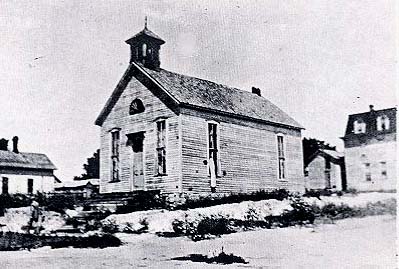(from Dodge City and Ford County, Kansas
1879-1920: Pioneer Histories and Stories)

The first church group was founded in November of 1872, only a few months after the establishment of Dodge City. The Union Church building, built in 1874 (its bell is exhibited on Boot Hill), was located on the northeast corner of First Ave. and Spruce St.
As the population increased, denominations were organized. Before these congregations built separate churches, they usually met on different time schedules in the Union Church.
The Presbyterians, organized in June 1878, were the first to build their own church. The Dodge City Times, June 8, 1878, announced the organizing of the first denominational organization:
“The wicked city of Dodge can at last boast of a Christian organization, a Presbyterian Church. It was organized last Sunday a week. We would have mentioned the matter last week but we thought it best to break the news gently to the outside world.”
The Rev. Ormond Wright, a young Presbyterian minister, served the Union Church, as well as the Presbyterians. They built a small Gothic-windowed frame church in 1880, and remodeled and enlarged the building in 1887 and again in 1900. Their present stone church was built in 1924-25. It stands where the first frame building stood, on the northwest corner of Railroad (Central) Ave. and Vine St.
The Methodists organized in August 1878, and built one block west of the Presbyterian Church in 1884. Their building was on the southwest corner of Vine St. and First Ave. In 1913, a large red brick building replaced their little frame church, on the same locations. In 1964, the property was sold to the city. Their large new church was erected in 1965 in the north part of town on Soule St.
The Baptists organized under Rev. N.G. Collins, and built their church in 1885. It was at the top of the hill on Cedar St. and Sixth Ave, east of the former Lincoln School. It was later moved to the northeast corner of Second Ave and Spruce St. The present red brick building between Ash and Hickory on Second Ave. was built in 1930.
The Christian Church organized in 1886 and in its early struggles moved into several downtown locations. They were able to build their own church in 1900, where the First National Bank building (Bank of America) now stands. During the summer of 1909, a new, larger church was built one block north on the southwest corner of Second Ave. and Vine St. It burned on Christmas Eve of that same year. The congregation moved into a new red brick building on that site the next year. They worshipped there for 45 years. In 1955, they erected a building on top of Boot Hill.
The first Roman Catholic missionary priest to come to Dodge City, held services in the early Sunday morning hours at the Union Church. In 1882, the Catholics built a little white frame church on the corner of Railroad (Central) Ave. and Cedar St. In 1914, it was replaced by the beautiful Sacred Heart Cathedral that stands where their first church was built.
The last of these first early churches, the St. Cornelius Episcopal Church, was founded in 1888 as an Episcopal Mission. It is the only one of the first churches still holding services in the original building, completed in 1898. The stone used for the building was from Henry Sturm’s ice house (brother-in-law of Elizabeth Schmidt). It is located on the northwest corner of First Ave. and Spruce St. [church is still in use, 2010].
“The Episcopal church, though small, is a little gem — the most artistic building in Dodge City. With its brown stone walls, colored glass windows and square bell tower, it is delightfully suggestive of the chapels of rural England.”
Robert M. Wright, Town Founder and President, Dodge City, the Cowboy Capital and the Great Southwest, 1913
(© 1996 – 2015 Ford County Historical Society, Inc.)
